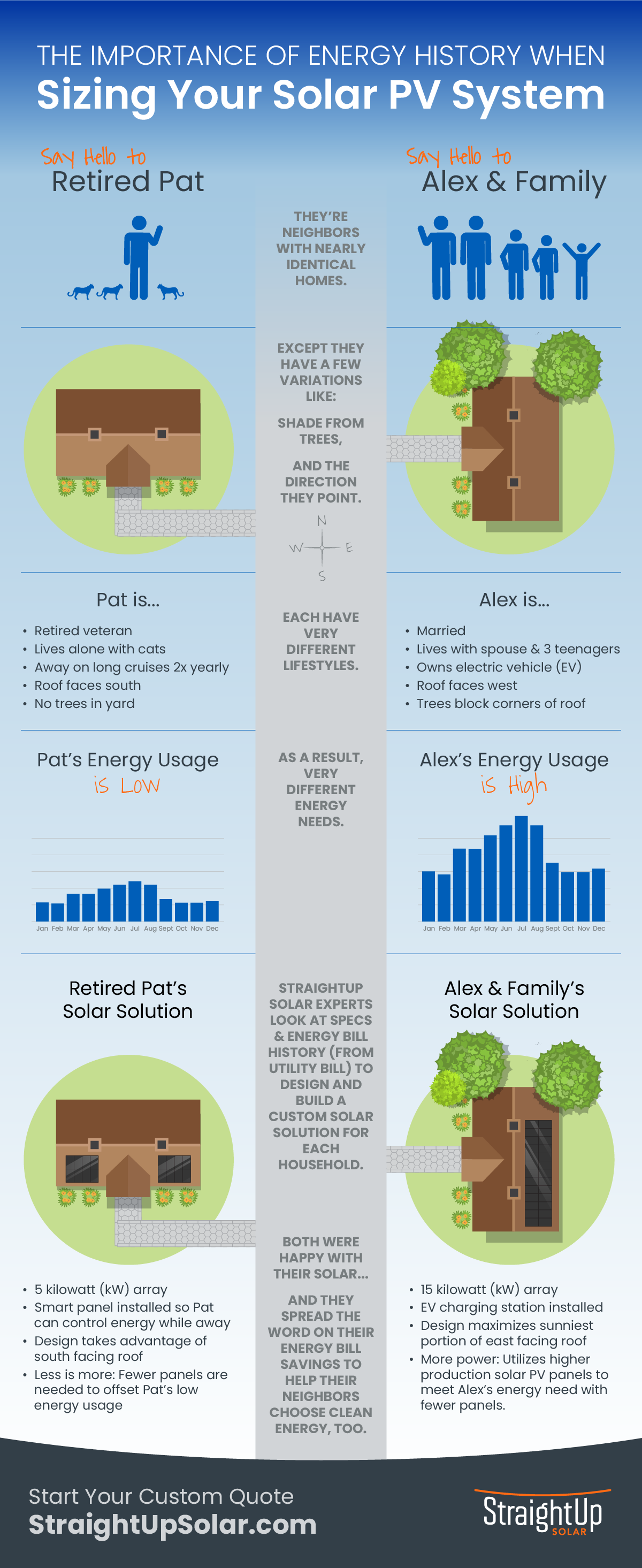Updated 8/29/2023
Have you ever wondered how many solar panels you would need to power your home? Like people, your home is unique. Even when two homes appear similar, they may have completely different energy needs and preferences. Solar is about more than just the panels, it’s an entire system that integrates with your home’s electricity. Though sizing begins with your energy usage, it also considers the available roof or property space (for ground-mounted arrays) and your energy offset goals.
View our handy infographic The Importance of Energy History When Sizing Your Solar PV System below. It shows how two neighbors, Retired Pat and Alex & Family, with nearly identical homes can require two completely different solar solutions. Then learn the process to determine system size.

Your utility bill is a good place to start to properly size your solar PV system, though there are many considerations. Referring to your actual home and energy usage is important for accuracy. Submitting your energy bill information upfront helps protect you from surprise costs down the road.
Our first step is to gather some information about your home and your past 12 months of energy usage from your utility provider. Month by month data are preferred to determine your energy patterns throughout the year and to account for seasonal shifts. Luckily, there are 4 ways to provide your energy bill data, with sharing your utility bill being the most time saving since we’ll need it to build your final project later.
If you have not occupied the home or building for the past 12 months, we can estimate energy usage based on your square footage and appliances in operation. That number determines the estimated energy needed to be offset by solar.
Once we know your energy usage on a monthly and annual basis, we will make some assumptions to determine your production factor. Every situation is different, and our calculations take into account your specific conditions. We will look at the possible shading of the array, locational coordinates, the azimuth (orientation) of proposed solar panel placement, and the expected solar panel that will be used. If you are deciding whether you should think about a roof or ground mount you can look here.
All these factors affect potential energy production. If you have optimal conditions your production factor will be higher, and if you have poor orientation or shading then your production factor will be lower. With net-metering and dual metering policies, we will work to get your solar design estimates as close to your energy usage as possible, or what makes the most financial sense for your situation. We will also recommend various equipment—like solar panels, inverters, battery storage, or smart panels—to best suit your needs, conditions, and goals.
A typical production factor ranges from 1.2-1.4. The production factor is multiplied by the system capacity, expressed in kilowatts (kW), to determine the solar array energy generation in kilowatt hours (kWh). This brings us back to annual electrical usage. An average home uses about 11,000 kWh per year. If this home had a production factor of 1.3 it would need a 8.46 kW solar array (8.46 kW= 11,000 kWh/1.3) to offset 100% of its energy with solar power.
StraightUp Solar sells solar panels with 400 to 485 watts of power. A 10 kW array is equivalent to 10,000 watts. To get the amount of panels needed for an 10000 watt array, the total amount of watts is divided by the watts per panel. For example this array would consist of 25 panels of 400 watt panels (10000/400=25).
Now that we know how many panels are needed, the question becomes, what will fit on the roof or area designated for the solar array? Solar panels are large, about 5.5 feet tall and 3 feet wide, which takes up quite a bit of space when strung together. Our Project Developers have the expertise to model what your home or business could look like with solar. They can factor in the building codes that local entities require for solar installations into their design. Their goal is to design a system that meets your energy goals in-line with existing codes and safety regulations.
Our solar proposals are free and no-obligation, and will give you the best idea of what you would need to consider when going solar. Get started today!